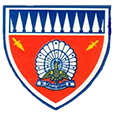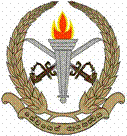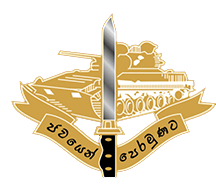This article needs additional citations for verification .(March 2018) |
| Sri Lanka Army Volunteer Force | |
|---|---|
| ශ්රී ලංකා යුද්ධ හමුදා ස්වේච්ඡා බළසේනාව இலங்கை இராணுவ தொண்டர் படையணி | |
 | |
| Active | 1881 – Present |
| Allegiance | |
| Branch | |
| Type | Reserve force |
| Size | 55,000 + |
| Volunteer Force HQ | Salawa, Kosgama |
| Colors | |
| Website | alt |
| Commanders | |
| Commandant of the Volunteer Force | Major General Lanka Amarapala |
| Deputy Commandant | Maj Gen W G P Sisira Kumara RSP |
| Principal Staff Officer | Brig M M Salwatura RWP RSP USP |
The Sri Lanka Army Volunteer Force (SLAVF) is the active-duty volunteer reserve force of the Sri Lanka Army. The SLAVF is separate from the Regular Force (known as the regular army) which consists of personal who are professional soldiers and its Regular Reserve, which comprises personal who have a mobilization obligation following their service in the regular army. The SLAVF consists of the volunteer force and the volunteer reserve; administration and recruitment of reserve personal is carried out by the Volunteer Force Headquarters in Shalawa, Kosgama which is headed by the Commandant of the Volunteer Force. It has a current strength of about 55,000 personnel. The SLAVF was known as the Ceylon Volunteer Force from 1949 to 1972 and the Sri Lanka Volunteer Force from 1972 to 1985.
Contents
- History
- Ceylon Light Infantry Volunteers
- Ceylon Defence Force
- Ceylon Volunteer Force
- 1962 attempted military coup
- Counter-insurgency operations
- Cadet Corps
- Vision
- Units
- Former units
- Training
- Awards and decorations
- General of the Volunteer Force of the Army
- Notable members
- See also
- References
- External links
All regiments and corps of the army have volunteer battalions/regiments attached with the exception of the Commando Regiment, Special Forces Regiment, and the Sri Lanka Corps of Military Police which only consists of regular units, while the Sri Lanka Rifle Corps, the Sri Lanka Army Pioneer Corps, and the Sri Lanka National Guard consists only of volunteer units.
The SLAVF traces its origins to the Ceylon Light Infantry Volunteers which was formed in 1881 as a Volunteer Force and evolved into the Ceylon Defense Force. With the formation of the Ceylon Army under the Army Act of 1949, the Ceylon Volunteer Force was established to function as the reserve force of the newly formed Ceylon Army. It consisted of non-career officers and soldiers, who were only mobilized during national emergencies. These personal were attached to local units that trained on weekends and under took a two week long annual training camp held traditionally in Diyatalawa. With Sri Lanka becoming a republic in 1972, it was renamed as the Sri Lanka Volunteer Force. In 1985, following the Manpower Mobilization and Auxiliary Forces Act, No. 40 of 1985, it was renamed as the Sri Lanka Army Volunteer Force. Since the start of the Sri Lankan Civil War in 1983, the force has been in a continues state of mobilization and has functioned as a supplement force to booster the regular army, by means of short service tenures and reduced recruitment restrictions based on age and qualifications. The SLAVF officers and soldiers are paid at a similar rate, while engaged on military activities, as their regular counterparts. Since 2014, recruitment of civil professionals to the volunteer reserve had re-started with the army reverting to a peace time role.












